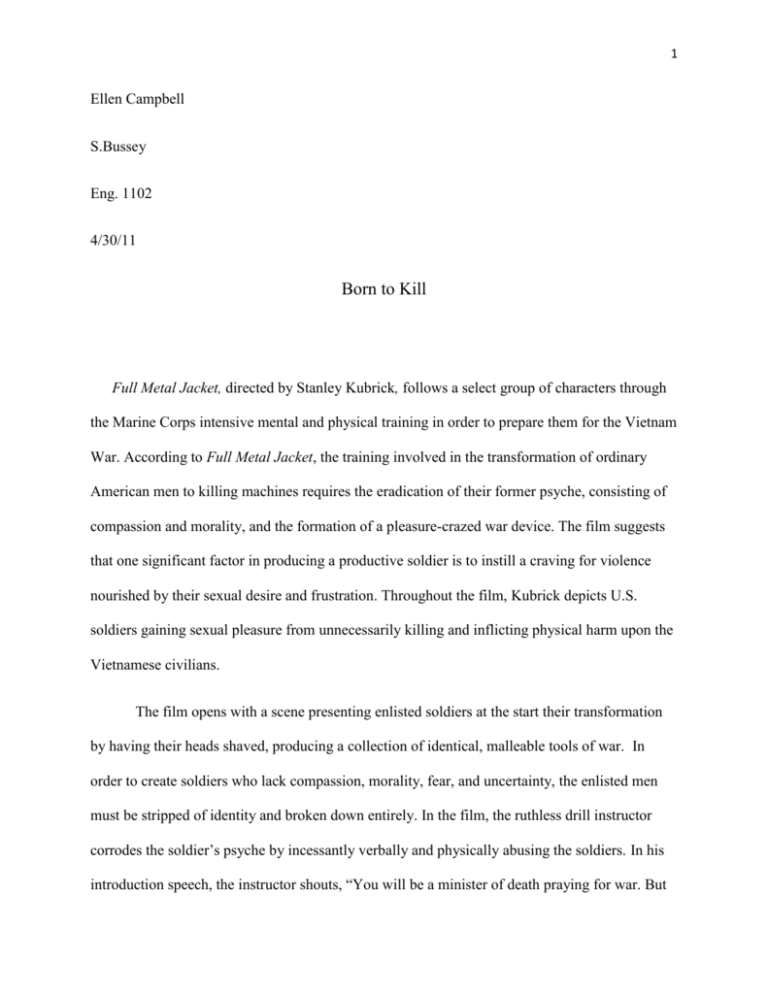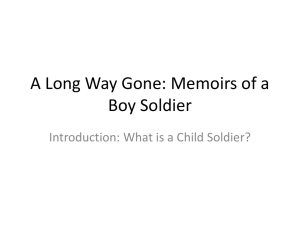
1
Ellen Campbell
S.Bussey
Eng. 1102
4/30/11
Born to Kill
Full Metal Jacket, directed by Stanley Kubrick, follows a select group of characters through
the Marine Corps intensive mental and physical training in order to prepare them for the Vietnam
War. According to Full Metal Jacket, the training involved in the transformation of ordinary
American men to killing machines requires the eradication of their former psyche, consisting of
compassion and morality, and the formation of a pleasure-crazed war device. The film suggests
that one significant factor in producing a productive soldier is to instill a craving for violence
nourished by their sexual desire and frustration. Throughout the film, Kubrick depicts U.S.
soldiers gaining sexual pleasure from unnecessarily killing and inflicting physical harm upon the
Vietnamese civilians.
The film opens with a scene presenting enlisted soldiers at the start their transformation
by having their heads shaved, producing a collection of identical, malleable tools of war. In
order to create soldiers who lack compassion, morality, fear, and uncertainty, the enlisted men
must be stripped of identity and broken down entirely. In the film, the ruthless drill instructor
corrodes the soldier’s psyche by incessantly verbally and physically abusing the soldiers. In his
introduction speech, the instructor shouts, “You will be a minister of death praying for war. But
2
until that day you are pukes. You are the lowest form of life on Earth. You are not even human,
fucking beings….Here you are all equally worthless.” The instructor brutally dehumanizes and
insults the men, viewing them as little more than maggots, until their conscience is eliminated.
Once the men have been reduced to nothing, the reconstruction into a desensitized killing
machine begins.
During basic training, the soldiers are forbidden sexual pleasure, forcing them to be sexually
deprived. The drill instructor harnesses their built up sexual frustration and their desire for sexual
satisfaction and channels it into a desire for violence. This transformation begins with the belief
that the rifle acts as a companion and a lover. A method that develops the soldier’s intimate
relationship with their rifle is marching chants. The soldiers are constantly shouting marches
implying that their gun, essentially violence, will provide them with companionship and sexual
satisfaction. The repetition of the chant, “I don’t want no beauty queen, I just want my M14,”
causes the soldiers to replace their desire for a female counterpart to satisfy their needs, with an
object whose actions produce similar rushes of physical pleasure. Another chant, “This is my
rifle, this is my gun; one is for shooting, one is for fun,” is sung while the soldiers grab their
genitalia. This brings to mind the Freudian Dream Analysis theory of phallic symbolism because
the rifles are held in an upright position and used to penetrate or injure other bodies. Holding
their genitals and rifles also suggests that the gun operates as an extension to their masculinity,
implying the soldiers acquire more respect as men with every kill they make. Throughout the
training, the association formed is to prepare the soldier’s for Vietnam, where they will put their
training into action and unleash their pent up aggression upon the Vietnamese civilians.
The second portion of the film is set in Southern Vietnam, while the soldiers are in active
duty. At this point, many the characters exhibit that they have been successfully rewired. Shortly
3
after the soldier’s arrival to Vietnam, the correlation between sex and violence is evident in a
scene filmed from an airborne helicopter. The viewers watch as a soldier guns down innocent
civilians, mainly women laboring in a field, while grunting “get some” repeatedly. The reference
to “getting sexual actions” while killing unnecessarily, demonstrates that the shooter is receiving
pleasure from playing his murderous game. Craig Kennedy, researcher at Vanderbuilt
University, conducted a study on mice in order to study the brain’s reward system with sexual
pleasure and violence. Concluding his findings Kennedy stated, "We learned from these
experiments that an individual will intentionally seek out an aggressive encounter solely because
they experience a rewarding sensation from it” (Bryner). Kennedy’s experiment reveals a similar
neurological response derived from sexual pleasure and the pleasure resulting from aggressive
behavior. This finding reinforces the film’s theme which shows the characters receiving similar
rewarding sensations caused by acts of violence and sex. The sensation motivates the soldiers to
seek out further opportunities to kill.
The soldiers in the film are surrounded by fellow sex-deprived male soldiers, creating an
overflowing amount of tension. Other than the companionship of prostitutes, the soldier’s
interaction with females is inhibited by circumstances of war. With no masculine, safe, or
acceptable means of fulfilling their sexual desire, the soldiers compensate by channeling this
frustration into acts of excessive aggression. Sigmund Freud theorized that two drives, sex and
aggression, are the motives behind every human action. Assuming Freud’s theory is correct, the
link created during the soldier’s training, which incorporates the instinctual drive for sex and
violence, generates a realistic mass of merciless killing machines.
4
Works Cited
Bryner, Jeanna. "Humans Crave Violence Just Like Sex | LiveScience." Editorial.
Psychopharmacology Jan. 2008. Current News on Space, Animals, Technology, Health,
Environment, Culture and History | LiveScience. Live Science, 17 Jan. 2008. Web. 02
May 2011.
Freud, S. (1900/1953). The interpretation of dreams. In The standard edition of the complete
psychological works of Sigmund Freud, Vols 4, 5 (ed. J. Strachey et al.). Hogarth Press,
London.
Freud, S. (1915-16/1961) Introductory lectures on psycho-analysis. In Standard Edition, Vol. 15,
(ed. J. Strachey et al.). Hogorth Press, London
5
Bibliography
Bryner, Jeanna. "Humans Crave Violence Just Like Sex | LiveScience." Editorial.
Psychopharmacology Jan. 2008. Current News on Space, Animals, Technology, Health,
Environment, Culture and History | LiveScience. Live Science, 17 Jan. 2008. Web. 02
May 2011.
Freud, S. (1900/1953). The interpretation of dreams. In The standard edition of the complete
psychological works of Sigmund Freud, Vols 4, 5 (ed. J. Strachey et al.). Hogarth Press,
London.
Freud, S. (1915-16/1961) Introductory lectures on psycho-analysis. In Standard Edition, Vol. 15,
(ed. J. Strachey et al.). Hogorth Press, London
Gutman, Laura. "The Deprivation of the Pleasure and the Violence." Mothers of Humanity Your Best Thinkable Experience. 4 Mar. 2011. Web. 01 May 2011.
Prescott, James W. "Article: Body Pleasure and the Origins of Violence." Origins of Peace and
Violence: Introduction. "The Bulletin of the Atomic Scientist", Nov. 1975. Web. 01 May
2011.
Webster, Richard. "Freud, Sex and Human Nature." Richard Webster: Sceptical Essays.
Richardwebster.net, 2002. Web. 01 May 2011.









